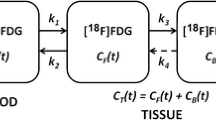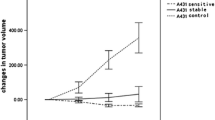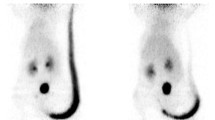Abstract
An early image of intra-tumor distribution of14C-labeled fluorodeoxy glucose (14C-FDG) was compared with a late image of18F-labeled FDG (18F-FDG) using mouse fibrosarcoma. Heterogeneous intra-tumor distribution of14C-FDG was observed 1 minute post injection of the tracer, whereas relatively homogeneous distribution of18F-FDG was seen 30 minutes later.14C-FDG was particularly taken up in the peripheral part of the tumor immediately after the tracer injection. A gradual and significant increase in18F-FDG accumulation with time was seen in the central part of tumor, which indicated an enhancement of anaerobic glycolysis. An initial uptake of18F-FDG was also compared with distribution of14C-iodoantipyrine and14C-thymidine uptake. Intratumoral distribution of initial uptake of18F-FDG showed almost the same regional distribution of14C-iodoantipyrine. A similar distribution of14C-thymidine as the initial uptake of18F-FDG was also observed. These results indicated that a high initial FDG uptake area seemed to be highly proliferative. A significant difference in the intratumoral distribution of FDG between early phase and late phase seemed to be related to heterogeneous biological characteristics of tumor cells.
Similar content being viewed by others
Reference
Wahl RL, Cody RL, Hutchins GD, Mudgett EE. Primary and metastatic breast carcinoma: initial clinical evaluation with PET with the radiolabeled glucose analogue 2-[F-18]-fluoro-2-deoxy-D-glucose.Radiology 1991; 179:765–770.
Delbeke D. Oncological applications of FDG PET imaging: brain tumors, colorectal cancer, lymphoma and melanoma.J Nucl Med 1999; 40:591–603.
Ak I, Stokkel MP, Pauwels EK. Positron emission tomography with 2-[18F]fluoro-2-deoxy-D-glucose in oncology. Part II. The clinical value in detecting and staging primary tumors.J Cancer Res Clin Oncol 2000; 126:560–574.
Okada J, Yoshikawa K, Itami M, Imaseki K, Uno K, Itami J, et al. Positron emission tomography using fluorine-18-fluorodeoxyglucose in malignant lymphoma: a comparison with proliferative activity.J Nucl Med 1992; 33:325–329.
Smith TAD, Titley J. Deoxyglucose uptake by head and neck squamous carcinoma: Influence of change in proliferative fraction.Int J Radiat Oncol Biol Phys 2000; 47:219–223.
Di Chiro G, DeLaPaz RL, Brooks RA, Sokoloff L, Kornblith PL, Smith BH, et al. Glucose utilization of cerebral gliomas measured by [18F]fiuorodeoxyglucose and positron emission tomography.Neurology 1982; 32:1323–1329.
Nieweg OE, Kim EE, Wong WH, Broussard WF, Singletary SE, Hortobagyi GN, et al. Positron emission tomography with fluorine-18-deoxyglucose in the detection and staging of breast cancer.Cancer 1993; 71:3920–3925.
Vesselle H, Schmidt RA, Pugsley JM, et al. Lung cancer proliferation correlates with [F-18]fluorodeoxyglucose uptake by positron emission tomography.Clin Cancer Res 2000; 6:3837–3844.
Nakata B, Chung YS, Nishimura S, Nishihara T, Sakurai Y, Sawada T, et al.18F-fluorodeoxyglucose positron emission tomography and the prognosis of patients with pancreatic adenocarcinoma.Cancer 1997; 79:695–699.
Folpe AL, Lyles RH, Sprouse JT, Conrad EU 3rd, Eary JF.(F-18) fluorodeoxyglucose positron emission tomography as a predictor of pathologic grade and other prognostic variables in bone, and soft tissue sarcoma.Clin Cancer Res 2000; 6:1279–1287.
Pauwels EK, Sturm EJ, Bombardieri E, Cleton FJ, Stokkel MP. Positron-emission tomography with [18F]fluorodeoxyglucose. Part I. Biochemical uptake mechanism and its implication for clinical studies.J Cancer Res Clin Oncol 2000; 126:549–559.
Smith TA. Facilitative glucose transporter expression in human cancer tissue.Br J Biomed Sci 1999; 56:285–292.
Reisser C, Eichhorn K, Herold-Mende C, Born AI, Bannasch P. Expression of facilitative glucose transport proteins during development of squamous cell carcinomas of the head and neck.Int J Cancer 1999; 80:194–198.
Arora KK, Pedersen PL. Functional significance of mitochondrial bound hexokinase in tumor cell metabolism. Evidence for preferential phosphorylation of glucose by intramitochondrially generated ATP.J Biol Chem 1988; 263:17422–17428.
Smith TA. Mammalian hexokinases and their abnormal expression in cancer.Br J Biomed Sci 2000; 57:170–178.
Brown RS, Leung JY, Fisher SJ, Frey KA, Ethier SP, Wahl RL. Intratumoral distribution of tritiated-FDG in breast carcinoma: correlation between Glut-1 expression and FDG uptake.J Nucl Med 1996; 37:1042–1047.
Kubota K, Tada M, Yamada S, Hori K, Saito A, Iwata R, et al. Comparison of the distribution of fluorine-18 fluoromisonidazole, deoxyglucose and methionine in tumour tissue.Eur J Nucl Med 1999; 26:750–757.
Gupta N, Gill H, Graeber G, Bishop H, Hurst J, Stephens T. Dynamic positron emission tomography with F-18 fluorodeoxyglucose imaging in differentiation of benign from malignant lung/mediastinal lesions.Chest 1998; 114:1105–1111.
Torizuka T, Nobezawa S, Momiki S, Kasamatsu N, Kanno T, Yoshikawa E, et al. Short dynamic FDG-PET imaging protocol for patients with lung cancer.Eur J Nucl Med 2000; 27:1538–1542.
Kobayashi K, Hosoi R, Momosaki S, Koike S, Ando K, Nishimura T, et al. Enhancement of the relative uptake of18F-FDG in mouse fibrosarcoma by rolipram.Ann Nucl Med 2002; 16:507–510.
Bentzen L, Vestergaard-Poulsen P, Nielsen T, Overgaard J, Bjornerud A, Briley-Saebo K, et al. Intravascular contrast agent-enhanced MRI measuring contrast clearance and tumor blood volume and the effects of vascular modifiers in an experimental tumor.Int J Radiat Oncol Biol Phys 2005; 61:1208–1215.
Ostergaard L, Hochberg FH, Rabinov JD, Sorensen AG, Lev M, Kim L, et al. Early changes measured by magnetic resonance imaging in cerebral blood flow, blood volume, and blood-brain barrier permeability following dexamethasone treatment in patients with brain tumors.J Neurosurg 1999; 90:300–305.
Miller JC, Pien HH, Sahani D, Sorensen AG, Thrall JH. Imaging angiogenesis: applications and potential for drug development.J Natl Cancer Inst 2005; 97:172–187.
Tozer GM, Prise VE, Wilson J, Locke RJ, Vojnovic B, Stratford MR, et al. Combretastatin A-4 phosphate as atumor vascular-targeting agent: early effects in tumors and normal tissues.Cancer Res 1999; 59:1626–1634.
Young SD, Marshall RS, Hill RP. Hypoxia induces DNA over replication and enhances metastatic potential of murine tumor cells.Proc Natl Acad Sci USA 1988; 85:9533–9537.
Brown MJ. The hypoxic cell: a target for selective cancer therapy.Cancer Res 1999; 59:5863–5870.
Chapman JD, Franko AJ, Sharplin J. A marker for hypoxic cells in tumours with potential clinical applicability.Br J Cancer 1981; 43:546–550.
Author information
Authors and Affiliations
Corresponding author
Rights and permissions
About this article
Cite this article
Inoue, O., Shukuri, M., Hosoi, R. et al. Distinct different intra-tumor distribution of FDG between early phase and late phase in mouse fibrosarcoma. Ann Nucl Med 19, 655–659 (2005). https://doi.org/10.1007/BF02985113
Received:
Accepted:
Issue Date:
DOI: https://doi.org/10.1007/BF02985113




